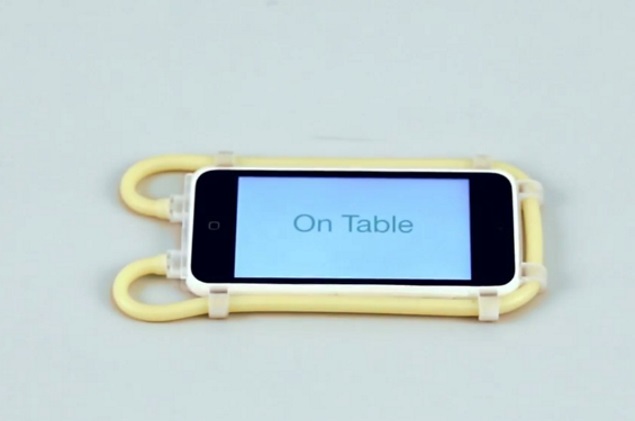- Home
- Science
- Science News
- 'Acoustruments' Use Sound Waves to Control Smartphones
'Acoustruments' Use Sound Waves to Control Smartphones

The researchers at Carnegie Mellon University and Disney Research drew inspiration from wind instruments in devising these mechanisms, which they call Acoustruments.
The idea is to use pluggable plastic tubes and other structures to connect the smartphone's speaker with its microphone.
The device can then be controlled by acoustically altering sounds as they pass through this system.
Just as a simple slide whistle or flute can produce expressive music, these Acoustruments can add a wide range of functionality to a smartphone, including proximity and pressure sensors.
And because no electrical circuitry is involved, the plastic Acoustruments can be made rapidly and inexpensively.
"We're providing people with tangible interactivity at basically no cost," said Gierad Laput, a PhD student in Carnegie Mellon's Human-Computer Interaction Institute (HCII).
"Using smartphones as computers to control toys, appliances and robots already is a growing trend, particularly in the maker community," said Laput, lead author of the study.
"Acoustruments can make the interactivity of these new 'pluggable' applications even richer," said Laput.
People who want to control a smartphone application while their eyes need to be focused elsewhere, for instance, might be less distracted by a tangible knob or button made possible with Acoustruments than with trying to glance at a touchscreen.
Applications that use smartphones as virtual reality displays make it impossible to use the touchscreen controls at all; Acoustruments enable users to make adjustments without disrupting the virtual reality experience.
The researchers have used Acoustruments to build an interactive doll, which responds when its tummy is poked; a smartphone case that can sense when it has been placed on a table or is being hand carried; and an alarm clock that provides physical on/off and snooze buttons.
Wind instruments take a sustained source of sound from a mouthpiece and then alter it by changing the cavity ? with a series of holes, as in a flute, or by changing its size, as with a trombone.
Acoustruments operate in a similar manner; the smartphone speaker produces continuous "sweeps" of ultrasonic frequencies; interactions that block, open holes or change the length or diameter of the plastic tubes connecting the speaker to the microphone alter this acoustic signal.
Experiments by the CMU and Disney researchers showed that Acoustruments can achieve 99 percent accuracy in controlling the device.
Acoustruments can be made with 3D printers, with injection moulds, or even by hand in some cases, Laput said.
For the latest tech news and reviews, follow Gadgets 360 on X, Facebook, WhatsApp, Threads and Google News. For the latest videos on gadgets and tech, subscribe to our YouTube channel. If you want to know everything about top influencers, follow our in-house Who'sThat360 on Instagram and YouTube.
- Samsung Galaxy Unpacked 2025
- ChatGPT
- Redmi Note 14 Pro+
- iPhone 16
- Apple Vision Pro
- Oneplus 12
- OnePlus Nord CE 3 Lite 5G
- iPhone 13
- Xiaomi 14 Pro
- Oppo Find N3
- Tecno Spark Go (2023)
- Realme V30
- Best Phones Under 25000
- Samsung Galaxy S24 Series
- Cryptocurrency
- iQoo 12
- Samsung Galaxy S24 Ultra
- Giottus
- Samsung Galaxy Z Flip 5
- Apple 'Scary Fast'
- Housefull 5
- GoPro Hero 12 Black Review
- Invincible Season 2
- JioGlass
- HD Ready TV
- Laptop Under 50000
- Smartwatch Under 10000
- Latest Mobile Phones
- Compare Phones
- Moto G15 Power
- Moto G15
- Realme 14x 5G
- Poco M7 Pro 5G
- Poco C75 5G
- Vivo Y300 (China)
- HMD Arc
- Lava Blaze Duo 5G
- Asus Zenbook S 14
- MacBook Pro 16-inch (M4 Max, 2024)
- Honor Pad V9
- Tecno Megapad 11
- Redmi Watch 5
- Huawei Watch Ultimate Design
- Sony 65 Inches Ultra HD (4K) LED Smart TV (KD-65X74L)
- TCL 55 Inches Ultra HD (4K) LED Smart TV (55C61B)
- Sony PlayStation 5 Pro
- Sony PlayStation 5 Slim Digital Edition
- Blue Star 1.5 Ton 3 Star Inverter Split AC (IC318DNUHC)
- Blue Star 1.5 Ton 3 Star Inverter Split AC (IA318VKU)












